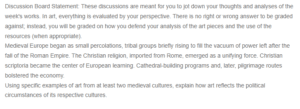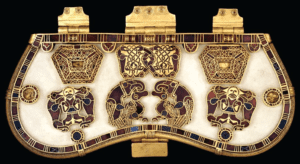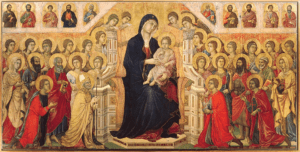The Evolution of Medieval Art in Europe
Purse cover from the Sutton Hoo ship
The purse lid from the Sutton Hoo ship burial displayed wealth during the medieval period in Anglo-Saxon society in England. The wealthy people during the medieval period used expensive ornaments such as the ship lid to display power, just like is the case today (Kleiner, 2020). Modern-age politicians display their expensive possessions, such as cars and airplanes, to express their power to the public. Also, the medieval art recovered from a burial ship shows a tradition where the rich were buried alongside their expensive possessions (Hunter, 2013). The purse lid was filled with glass, gold, ornamentation, and other expensive art pieces. Other pieces discovered alongside the purse lid include shields, helmets, swords, and the Sutton Hoo helmet. Such discoveries show that politicians from the medieval age used their wealth to finance war and conflict.
Duccio di Buoninsegna, Virgin and Child Enthroned with Saints
‘Virgin and Child Enthroned with Saints’ painting represents the traditional Christian family. It shows Mary, the Virgin, sitting on the throne while holding Baby Jesus. The painting shows other saints surrounding Mary, probably offering a benediction (Antonovich et al., 2019). Having Mary sitting on the throne represents the immense political power the Catholic Church has held in Italy from the medieval period to date. Today, the Vatican holds so much power in Italy that it operates like an independent state even though there is an official national government. The Italians in the late Medieval period considered the Church an essential institution in managing society’s affairs (Goodson, 2018). The Catholic Church still holds significant power in Italy today.
References
Antonovich, B. S., Gennadievich, B. A., & Aleksandrovich, S. T. (2019). The role of the Church in medieval society. Bulletin Social-Economic and Humanitarian Research, (1 (3)), 58-64.
Goodson, C. (2018). Italy and Early Medieval Europe. In www.academia.edu. https://www.academia.edu/39642137/Italy_and_Early_Medieval_Europe
Hunter, R. (2013). My Favourite History Place: Sutton Hoo: A Secret Uncovered, A Mystery Unsolved. Historian, (119), 38.
Kleiner, F. S. (2020). Gardner’s Art through the Ages: A Global History (16th ed.). Cengage Learning.
ORDER A PLAGIARISM-FREE PAPER HERE
We’ll write everything from scratch
Question

The Evolution of Medieval Art in Europe
Discussion Board Statement: These discussions are meant for you to jot down your thoughts and analyses of the week’s works. In art, everything is evaluated by your perspective. There is no right or wrong answer to be graded against; instead, you will be graded on how you defend your analysis of the art pieces and the use of the resources (when appropriate).
Medieval Europe began as small percolations, tribal groups briefly rising to fill the vacuum of power left after the fall of the Roman Empire. The Christian religion, imported from Rome, emerged as a unifying force. Christian scriptoria became the center of European learning. Cathedral-building programs and, later, pilgrimage routes bolstered the economy.
Using specific examples of art from at least two medieval cultures, explain how art reflects the political circumstances of its respective cultures.



